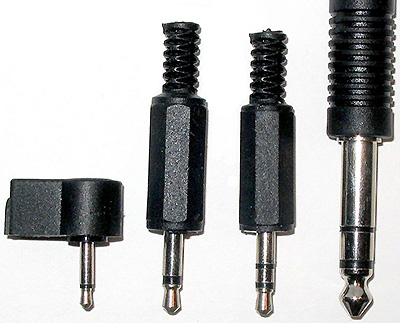Audio Connector
Posted on March 5, 2016 by KVMGalore | 0 comments
 In electronics, audio connector, also known as a phone connector, phone jack, audio jack or jack plug, is a common family of connectors typically used for analog signals, primarily audio.
In electronics, audio connector, also known as a phone connector, phone jack, audio jack or jack plug, is a common family of connectors typically used for analog signals, primarily audio.
The connector is cylindrical in shape, typically with two, three or four contacts. Three-contact versions are known as TRS connectors, where T stands for "tip", R stands for "ring" and S stands for "sleeve". Similarly, two- and four-contact versions are called TS and TRRS connectors respectively.
This type connector was invented for use in telephone switchboards in the 19th century and is still widely used. Specific models are termed stereo plug, mini-stereo, mini jack, headphone jack and microphone jack, or are referred to by size, i.e. 3.5 mm or 6.35 mm.
In its original configuration, the outside diameter of the "sleeve" conductor is ¼ inch (exactly 6.35 mm). The mini connector has a diameter of 3.5 mm (approx. ⅛ inch) and the sub-mini connector has a diameter of 2.5 mm (approx. 3⁄32 inch).
The most immediately recognizable connector is the 3.5 mm (⅛") version of this connector often seen as the plug on the end of a pair of headphones.

3.5 mm tip-ring-sleeve (TRS) is very common as the connector for headphones or audio output signals on MP3 players or computers. Some cell phones provide a 2.5 mm tip-ring-ring-sleeve (TRRS) jack for connecting to headphones that also include a microphone for hands-free communications.
¼" size connectors find a lot of use in the professional audio and music community - most electric guitars and amplifiers have ¼" tip-sleeve (TS) jacks on them.
The 3.5 mm (miniature) and 2.5 mm (sub-miniature) sizes were originally designed as two-conductor connectors for earpieces on transistor radios. The 3.5 mm connector, which is the most commonly used in portable application today, has been around at least since the Sony EFM-117J radio which was released in 1964. It became very popular with its application on the Walkman in 1979.
Three- four- and five-conductor versions of the 3.5 mm plug are used for certain applications.
A three-conductor version is often used in MP3 music players, ipods and smartphones, providing stereo sound.
A four-conductor version is often used in compact camcorders and portable media players, and sometimes also in laptop computers and smartphones, providing stereo sound plus a video signal.
Proprietary interfaces using both four- and five-conductor versions also exist, where the extra conductors are used to supply power for accessories. The four-conductor 3.5 mm plug is also used as a speaker-microphone connector on handheld amateur radio transceivers and on mobile phones.
The most common arrangement remains to have the male plug on the cable and the female socket mounted in a piece of equipment: the original intention of the design.
A considerable variety of line plugs and panel sockets is available, including plugs suiting various cable sizes, right-angle plugs, and both plugs and sockets in a variety of price ranges and with current capacities up to 15 amperes for certain heavy duty ¼ inch versions intended for loudspeaker connections.





